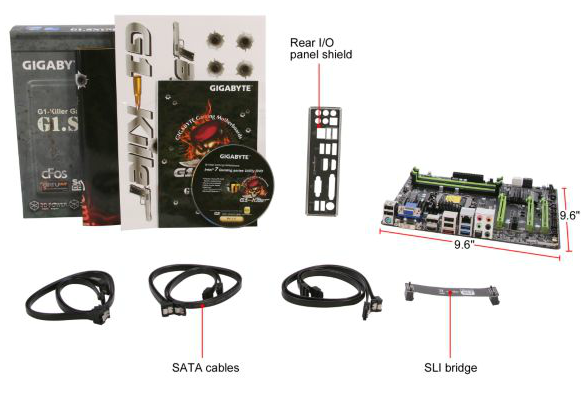ASUS Maximus V Gene vs. Gigabyte G1.Sniper M3 Review
by Ian Cutress on May 13, 2013 10:00 AM EST- Posted in
- Motherboards
- Gigabyte
- Asus
- MicroATX
- Z77
Gigabyte G1.Sniper M3 In The Box
Over the past 24 months, it has been somewhat exciting looking into the minds of manufacturers if you purely look into their bundles. You can tell when a manufacturer is skimping on the extras to meet a lower price point – less SATA cables is a big giveaway, or not including a USB 3.0 bracket when two USB 3.0 headers are on board. Gigabyte in the past usually split their bundles – anything below a UD5 is usually short of items, but UD5 and above (including the gaming ranges) has plenty to say for itself.
In the G1.Sniper M3 we get:
Rear IO Shield
Driver Disk
User Guide
Two Gigabyte Posters, Glossy
Six SATA Cables
Flexi SLI Bridge


Obviously the things that strike out are the posters. I could image a freshman student in college putting these on the wall, but anything other than that and it seems a bit odd. Being in my late twenties and married, I personally would not want to put these on the wall even if I was allowed to!
Gigabyte G1.Sniper M3 Overclocking
Note: Ivy Bridge does not overclock like Sandy Bridge. For a detailed report on the effect of voltage on Ivy Bridge (and thus temperatures and power draw), please read Undervolting and Overclocking on Ivy Bridge.
Experience with Gigabyte G1.Sniper M3
Much like overclocking with the ASUS Maximus V Gene, we have three automatic overclock options to choose from in the operating system, along with BIOS options for manual overclocks. The Gigabyte does not offer the automatic options in the BIOS, but they do have an additional OS mode to test for an overclock, dubbed ‘Automatic Tuning’.
For the automatic overclocks, the EasyTune6 software packed in plenty of voltage, using both a higher than stock fixed voltage with an offset. As a result two of the three settings were stable, although the temperature under load was a cause for concern. Due to our relatively bad CPU, the more extreme third setting and auto tuning were not able to perform.
Manual overclock options on the G1.Sniper 3 are split between those in ET6 (which are enabled at boot time when the software is loaded) or those that are set in the BIOS. In the BIOS the options are spread around a few menus – the important ones of CPU multiplier, CPU voltage and Load Line Calibration are in all different menus to add to the confusion. Despite this, overclock performance was reasonable, matching the ASUS MVG.
Methodology:
Our standard overclocking methodology is as follows. We select the automatic overclock options and test for stability with PovRay and OCCT to simulate high-end workloads. These stability tests aim to catch any immediate causes for memory or CPU errors.
For manual overclocks, based on the information gathered from previous testing, starts off at a nominal voltage and CPU multiplier, and the multiplier is increased until the stability tests are failed. The CPU voltage is increased gradually until the stability tests are passed, and the process repeated until the motherboard reduces the multiplier automatically (due to safety protocol) or the CPU temperature reaches a stupidly high level (100ºC+). Our test bed is not in a case, which should push overclocks higher with fresher (cooler) air.
Automatic Overclock:
Using EasyTune6, CPU Level 1 attempts a 41x102 overclock (4182 MHz) and applies 1.295 volts to the CPU along with a +0.150 volt offset. This setting was stable, giving 1.392 volts on the CPU at load, a score of 1519.50 in PovRay, and a peak temperature of 85ºC in OCCT.
CPU Level 2 attempts a 43x103 overclock (4429 MHz) and applies 1.300 + 0.150 volts on the CPU. This setting was stable, giving 1.404 volts on the CPU at load, a score of 1615.00 in PovRay and a peak temperature of 86ºC in OCCT.
CPU Level 3 attempts a 45x104 overclock (4680 MHz) and applies 1.345 + 0.150 volts on the CPU. This setting was not stable, giving 1.476 volts on the CPU at load, causing a memory error in PovRay and a BSOD in OCCT.
Auto Tuning in ET6 tries 43x105 (4515 MHz) at 1.400 volts, but this setting causes a BSOD on boot.
Manual Overclock:
Starting at our base settings of 4.0 GHz on the CPU and 1.100 volts, stability was tested to find the minimum stable voltage as the multiplier was increased. Results are tabulated thus:











31 Comments
View All Comments
cmdrdredd - Monday, May 13, 2013 - link
For overclocking and enthusiast oriented boards you get what you pay for. This review wasn't supposed to be catered to budget builders at all.takeship - Monday, May 13, 2013 - link
I built with first the Asus Gene V, and then the M3 Sniper, all in the last 9 months. Biggest difference: the pci & fan header layout on the Gigabyte made more sense, vs transiting nearly the length of the board with the 3rd Asus fan header. Makes a mess of routing. Headers all along the edges, and the lower (none-blocking) location of the second x8 pcie were a big plus. Not to mention the larger CPU socket area. I seem to recall the Gigabyte had a better fan control setup as well, though I could be wrong (and anyways the 3D UEFI is not good). Top it off with the fact that the Gigabyte was on sale for $140 when I picked it up, far below the $205 I paid for the Asus. I love my Asus board, but I would recommend the Gigabyte over it in an instant.Samus - Monday, May 13, 2013 - link
Yikes, lost me at Creative Labs...chedrz - Monday, May 13, 2013 - link
I love my Sniper M3. It's rock-solid, stable, hasn't given me any sort of problem. I guess that makes it the exact opposite of every ASUS board I've ever owned. I was a little worried about the Creative sound also, but I fortunately have a Xonar D2X that I've been using. This board's a champ.jrs77 - Tuesday, May 14, 2013 - link
I'd wish that GA or ASUS release some high-end, but stripped motherboards where there's only the absolute minimum of components on them.Take sound for example. An $30 USB-DAC will beat any onboard-sound solution easily, and noone really needs anything else then the PEG-slots either.
The mass of USB- and SATA-ports is a waste of efforts aswell, as you usually have a single SSD + HDD, mouse, keyboard, USB-DAC and the front-USB ports for your camera etc.
Less is more, and less components result in less errors. Additionally, less components result in less board-temperature and cleaner routing.
Will never happen unfortunately :/
Rick83 - Tuesday, May 14, 2013 - link
The X58-OC did happen. It was apparently a complete failure, judging by how often in featured in giveaways.It may have been pared back a bit too much though, with only two USB ports on the back, IIRC. Of course, you can use an external hub for mice and keyboards, so that won't matter.
But given how it went the first time around, I doubt that anyone else is going to try that any time soon again.
Also, I think you're oversimplifying. PCI cards still exist, and plenty of people have one that they'd rather use in their new machine. Network cards, sound cards, that kind of thing. Why buy new, when you have a card that works perfectly well?
Also, I am currently using every one of the MIVG's rear USB outputs, AND two USB hubs.
Charging mini and micro USB, managing screens, two keyboards, a mouse, an IR receiver, a Joystick, a floppy drive, a camera - I don't think paring back on USB is an option, as I don't even have a printer, scanner, modem or DAC/ADC attached. I'm also using 4 SATA ports, for two SSDs, a hotswap bay and an optical drive. Going down to two is very limiting, given how many disks are supported by almost all cases.
Considering that you want to market to the masses in order to recoup your investment, as a mainboard maker, I doubt anyone is going to cut features (even features that are there anyway, due to the platform) only to make an expensive board, with no option for expansion.
And as for onboard sound: It's plenty good to attach a microphone, and the optical outs are also usually just dandy. Saves a USB port for other devices than a USB-DAC.
JDG1980 - Tuesday, May 14, 2013 - link
Check out the Asus P8B-X.Rick83 - Tuesday, May 14, 2013 - link
I still don't get, why GigaByte perpetually insists on adding VGA D-Sub headers to the I/O-Panel. That interface is so obsolete, it's a complete joke, and cutting back on USB 2 headers is the result. DP and HDMI are nice to have, there's a case for DVI, in case you want to dual-screen, but VGA is just not used anymore. Even budget TFTs should be coming with only digital inputs by now.It's interesting to see, that the Creative solution is clearly targeted at 48kHz usage, with results getting worse, at higher sampling rates.
When the M3 first was announced, I was excited, because finally there was a rival to the Gene series. But this first iteration is (spec-wise and price-wise) simply not in the same league.
The placement of the second x8 PCIe is the only thing that's good about it, as you probably won't run two big GPUs in a micro-ATX case, hence by putting it down there, the option remains for big cases, and in small cases there's more PCIe bandwidth available.
The downside is, that you cannot install a big card in the second PCIe, if a combination of large coolers blocks the first PCIe slot.
Ilias78 - Tuesday, May 14, 2013 - link
Always the same story with Ian: Loves Asus motherboards, while dissing every other brand...just4U - Tuesday, May 14, 2013 - link
Currently the M3 is my board of choice. I pick it over the Asus variant every time (if in stock) It's $50 cheaper than the Maximus V Gene (here in Calgary) and I like the fact that they didn't cheap out on the sound option yet still include the Intel Nic. It hits in all the right areas.